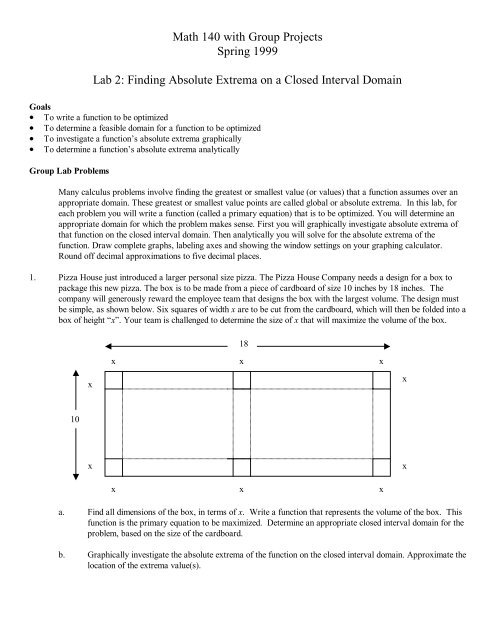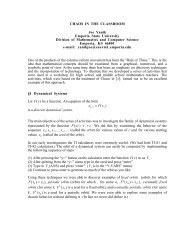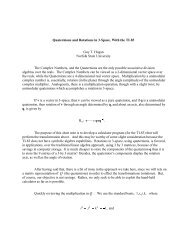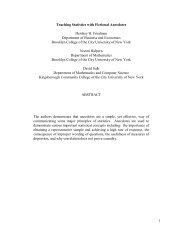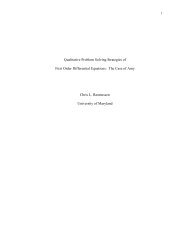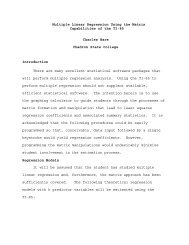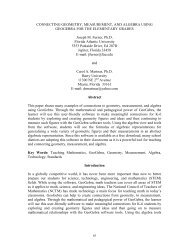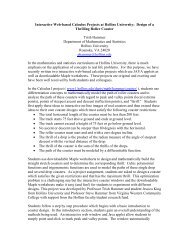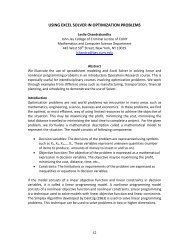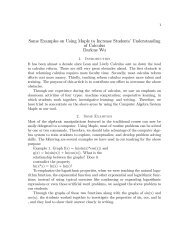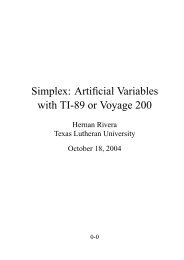Math 140 with Group Projects Spring 1999 Lab 2: Finding Absolute ...
Math 140 with Group Projects Spring 1999 Lab 2: Finding Absolute ...
Math 140 with Group Projects Spring 1999 Lab 2: Finding Absolute ...
Create successful ePaper yourself
Turn your PDF publications into a flip-book with our unique Google optimized e-Paper software.
<strong>Math</strong> <strong>140</strong> <strong>with</strong> <strong>Group</strong> <strong>Projects</strong><br />
<strong>Spring</strong> <strong>1999</strong><br />
<strong>Lab</strong> 2: <strong>Finding</strong> <strong>Absolute</strong> Extrema on a Closed Interval Domain<br />
Goals<br />
• To write a function to be optimized<br />
• To determine a feasible domain for a function to be optimized<br />
• To investigate a function’s absolute extrema graphically<br />
• To determine a function’s absolute extrema analytically<br />
<strong>Group</strong> <strong>Lab</strong> Problems<br />
Many calculus problems involve finding the greatest or smallest value (or values) that a function assumes over an<br />
appropriate domain. These greatest or smallest value points are called global or absolute extrema. In this lab, for<br />
each problem you will write a function (called a primary equation) that is to be optimized. You will determine an<br />
appropriate domain for which the problem makes sense. First you will graphically investigate absolute extrema of<br />
that function on the closed interval domain. Then analytically you will solve for the absolute extrema of the<br />
function. Draw complete graphs, labeling axes and showing the window settings on your graphing calculator.<br />
Round off decimal approximations to five decimal places.<br />
1. Pizza House just introduced a larger personal size pizza. The Pizza House Company needs a design for a box to<br />
package this new pizza. The box is to be made from a piece of cardboard of size 10 inches by 18 inches. The<br />
company will generously reward the employee team that designs the box <strong>with</strong> the largest volume. The design must<br />
be simple, as shown below. Six squares of width x are to be cut from the cardboard, which will then be folded into a<br />
box of height “x”. Your team is challenged to determine the size of x that will maximize the volume of the box.<br />
18<br />
x x x<br />
x<br />
x<br />
10<br />
x<br />
x<br />
x<br />
x<br />
x<br />
a. Find all dimensions of the box, in terms of x. Write a function that represents the volume of the box. This<br />
function is the primary equation to be maximized. Determine an appropriate closed interval domain for the<br />
problem, based on the size of the cardboard.<br />
b. Graphically investigate the absolute extrema of the function on the closed interval domain. Approximate the<br />
location of the extrema value(s).
c. Analytically solve for the absolute extrema of the function. Use calculus to find the critical number(s) of<br />
the function. Evaluate the primary equation function at the endpoints of the domain and at the critical<br />
number(s) of the function. Find the dimensions of the box that has the maximum volume.<br />
2. Cheap Pop, a new Fortune 500 company, plans to sell soda pop in 12-ounce cylindrical cans. Cheap Pop will<br />
generously reward the employee team that designs the can that can be constructed <strong>with</strong> the least amount of material.<br />
Your team is challenged to determine the dimensions that will minimize the surface area of the can. (Your team<br />
knows that 12 liquid ounces is approximately equal to 355 cubic centimeters.)<br />
a. In order to represent the surface area of the can as a function of r, you will first need to write a secondary<br />
equation that represents the volume of the can. Solve the volume equation for h, in terms of r. Substitute<br />
the expression for h into the surface area function. The surface area function is the primary equation to be<br />
minimized. Determine an appropriate closed interval domain for the problem.<br />
b. Graphically investigate the absolute extrema of the function on the closed interval domain.<br />
Approximate the location of the extrema value(s).<br />
c. Analytically solve for the absolute extrema of the function. Use calculus to find the<br />
critical number(s) of the function. Evaluate the primary equation function at the endpoints<br />
of the domain and at the critical number(s) of the function. Find the dimensions of the can<br />
that has the minimum surface area.<br />
3. Dune Buggy Annual Timed Races are held at Parched Desert. Your team driver starts in the desert at point A,<br />
located 40 miles from point B. As shown below, points B and D lie on a straight road. Your driver can travel at 45<br />
mph on the desert and 75 mph on the road. Your team will win this prestigious race if your driver arrives at the<br />
finish line, located at point D, in 85 minutes or less. The distance between points B and D is 50 miles. Your team is<br />
challenged to determine the route that will minimize the time of travel to win the race.<br />
40<br />
A<br />
B x C 50-x D<br />
a. Suppose your driver travels to point C located x miles down the road from point B, as shown above.<br />
To minimize time, write an equation that represents time as a function of distance and rate. This function<br />
is the primary equation to be minimized. Determine an appropriate closed interval domain for the problem.<br />
b. Graphically investigate the absolute extrema of the function on the closed interval domain.<br />
Approximate the location of the extrema value(s).<br />
c. Analytically solve for the absolute extrema of the function. Use calculus to find the critical number(s) of the<br />
function. Evaluate the time function at the endpoints of the domain and at the critical number(s) of the<br />
function. Describe the route that will minimize the total driving time.<br />
Acknowledgments: Problems 2 and 3 were adapted from Calculus, Gerald L. Bradley and Karl J. Smith, Prentice<br />
Hall, 2 nd Edition, <strong>1999</strong>.


